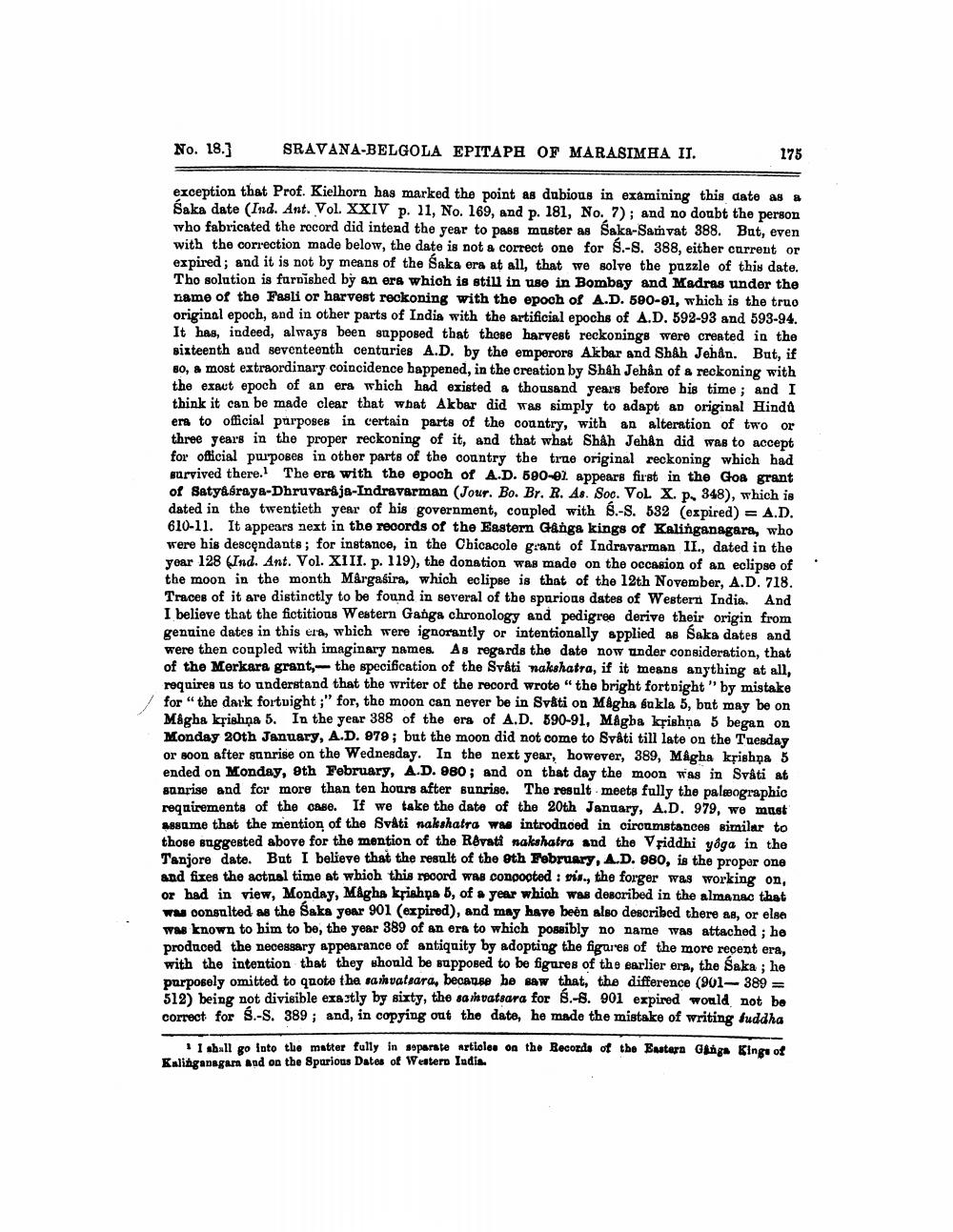________________
No. 18.]
SRAVANA-BELGOLA EPITAPH OF MARASIMHA II.
exception that Prof. Kielhorn has marked the point as dubious in examining this date as a Saka date (Ind. Ant. Vol. XXIV p. 11, No. 169, and p. 181, No. 7); and no doubt the person who fabricated the record did intend the year to pass muster as Saka-Samvat 388. But, even with the correction made below, the date is not a correct one for S.-S. 388, either current or expired; and it is not by means of the Saka era at all, that we solve the puzzle of this date. Tho solution is furnished by an era which is still in use in Bombay and Madras under the name of the Fasli or harvest reckoning with the epoch of A.D. 590-91, which is the true original epoch, and in other parts of India with the artificial epochs of A.D. 592-93 and 593-94. It has, indeed, always been supposed that these harvest reckonings were created in the sixteenth and seventeenth centuries A.D. by the emperors Akbar and Shah Jehân. But, if so, a most extraordinary coincidence happened, in the creation by Shah Jehân of a reckoning with the exact epoch of an era which had existed a thousand years before his time; and I think it can be made clear that what Akbar did was simply to adapt an original Hindu era to official purposes in certain parts of the country, with an alteration of two or three years in the proper reckoning of it, and that what Shah Jehan did was to accept for official purposes in other parts of the country the true original reckoning which had survived there. The era with the epoch of A.D. 590-01. appears first in the Goa grant of Satyasraya-Dhruvaraja-Indravarman (Jour. Bo. Br. R. As. Soc. Vol. X. p. 348), which is dated in the twentieth year of his government, coupled with S.-S. 532 (expired) = A.D. 610-11. It appears next in the records of the Eastern Ganga kings of Kalinganagara, who were his descendants; for instance, in the Chicacole grant of Indravarman II., dated in the year 128 (Ind. Ant. Vol. XIII. p. 119), the donation was made on the occasion of an eclipse of the moon in the month Mârgasira, which eclipse is that of the 12th November, A.D. 718. Traces of it are distinctly to be found in several of the spurious dates of Western India. And I believe that the fictitious Western Ganga chronology and pedigree derive their origin from genuine dates in this era, which were ignorantly or intentionally applied as Saka dates and were then coupled with imaginary names. As regards the date now under consideration, that of the Merkara grant, the specification of the Svâti nakshatra, if it means anything at all, requires us to understand that the writer of the record wrote "the bright fortnight" by mistake for "the dark fortuight;" for, the moon can never be in Svâti on Magha sukla 5, but may be on Magha krishna 5. In the year 388 of the era of A.D. 590-91, Magba krishna 5 began on Monday 20th January, A.D. 979; but the moon did not come to Svâti till late on the Tuesday or soon after sunrise on the Wednesday. In the next year, however, 389, Mâgha krishna 5 ended on Monday, 9th February, A.D. 980; and on that day the moon was in Svâti at sunrise and for more than ten hours after sunrise. The result meets fully the paleographic requirements of the case. If we take the date of the 20th January, A.D. 979, we must assume that the mention of the Svati nakshatra was introduced in circumstances similar to those suggested above for the mention of the Rêvati nakshatra and the Vriddhi yoga in the Tanjore date. But I believe that the result of the 9th February, A.D. 980, is the proper one and fixes the actual time at which this record was concocted: vis., the forger was working on, or had in view, Monday, Magha krishna 5, of a year which was described in the almanac that was consulted as the Saka year 901 (expired), and may have been also described there as, or else was known to him to be, the year 389 of an era to which possibly no name was attached; he produced the necessary appearance of antiquity by adopting the figures of the more recent era, with the intention that they should be supposed to be figures of the earlier era, the Saka; he purposely omitted to quote the samvatsara, because he saw that, the difference (901-389 = 512) being not divisible exactly by sixty, the samvatsara for B.-8. 901 expired would not be correct for S.-S. 389; and, in copying out the date, he made the mistake of writing suddha
175
I shall go into the matter fully in separate articles on the Records of the Eastern Ganga Kings of Kalinganagara and on the Spurious Dates of Western India.




